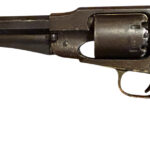Excellent Example of an Original Union Forage Cap
SOLD
Excellent Example of an Original Union Forage Cap – This cap remains in overall superb condition – great color, virtually no insect nips, strong and complete interior with original light brown cotton lining, original sweatband in excellent / complete condition, chinstrap and Eagle I cuff buttons. The cap, like all Federal issue forage caps during the Civil War, was the Model 1858 forage cap. The cap’s design was regulated by the U.S. Army through official channels, which outlined the standard specifications. The terms Type I and Type II to describe Federal issue caps, are seemingly modern modes of classification induced by some variances in forage caps seen today and are likely evidence of manufacture by different entities. Type I caps as enumerated as such today, have smaller top discs and a crescent, flat visor; the Type II caps, again as designated such today, have larger top discs and a more cylindrical body, with a flat, squarish visor. This cap appears to possibly have been manufactured by George Hoff & Company – this company contracted with the Federal Government to make approximately 620,000 forage caps during the period from 1861 to 1865. Hoff’s caps are characterized by exhibiting larger discs, with a more cylindrical body; this cap does not really have an overtly cylindrical body, but does have a McDowell style visor, usually associated with Type I or early war caps. On the exterior crown of the cap is an original, stamped brass, Infantry horn insignia, affixed via bent loops inside the interior crown – this insignia was present when we obtained the cap, so we cannot affirm that it was placed on the cap during the Civil War. Regardless of type designation, this cap is one of the best examples that we have had.
Evolution of the Federal regulations for the Model 1858 forage cap
- 1858: Adoption and initial regulation. The U.S. Army adopted the forage cap for fatigue, or everyday wear, in 1858. The initial regulations called for the cap’s crown to have a welt (piping) in a different color to denote the soldier’s branch of service.
- 1861: Standardization. At the beginning of the war, this practice was discontinued. An updated regulation in early 1861 required all forage caps to be made entirely of dark blue wool, including the crown welts.
- Mass production: The military issued millions of these caps throughout the war, manufactured by government contractors to the official pattern. Soldiers could also purchase privately made versions, which were common among officers and often featured higher quality.
- Construction: The cap was made from dark blue wool with a circular, stiffened top, and a tarred or painted leather visor. A leather chinstrap was secured by two small eagle buttons on the sides.
- Informal use: While the military had strict regulations for dress uniforms, the forage cap was a practical item for field use, and the specific rules for wearing it were often disregarded. Soldiers frequently wore various forms of insignia on their caps, even though regulations typically only specified company letters.


























